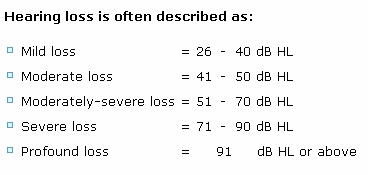|
Auditory System
Hearing is a complex process of picking up sound from
the ear and become meaningful by the coordination
between auditory nerve and brain's auditory processing
centers. The human ear consists of three sections: the
outer ear, the middle ear, and the inner ear. The outer
ear includes the visible part of the ear (pinna) and the
external auditory canal. The middle ear is an air-filled
space separated from the outer ear by the eardrum. The
middle ear contains Eustachian tube and three small
bones (called malleus, incus and stapes), which
constitute the ossicular chain. These bones connect the
eardrum to the inner ear. The most important feature of
inner ear responsible for hearing is the cochlea. In
addition, the semicircular canal of inner ear is
responsible for balance. Both of them are full of fluid
and have thousands of tiny nerve fibers.

What is Hearing Loss?
Many diseases can affect the hearing of children and
adults. There are two types of hearing loss: congenital
or acquired. If a hearing loss is congenital, it is
present at birth, associated with the birth process, or
to have developed in the first few days of life. In
contrast, acquired hearing loss represent the hearing
disability has not present at birth but developed later,
either during childhood or adulthood.

Hearing loss can also be classified as either
pre-lingual or post-lingual. A preolingual hearing loss
occurs before the acquisition of language and speech. A
post-lingual hearing loss is one occurring after
developing a first language.
The hearing level (HL) is a quantified measure of
“normal” hearing in decibels (dB). A decrease in hearing
sensitivity is indicated by larger values of hearing
level, thus higher dB indicating worse hearing ability.
Normal human ear can respond to sounds that are very
faint (i.e. less that 25 dB (HL)). Otherwise, the
patient should suffer from hearing loss. Degree of
hearing loss refers to the severity of the loss. There
are typically five broad categories. The numbers are
representative of the patient's softest intensity that
sound is perceived.
|